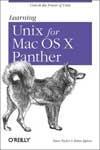Learning Unix for Macintosh OS X Panther
Author(s): Dave Taylor and Brian Jepson
Publisher: O’Reillly and Associates
ISBN: 0596006179 Pages: 155
Reviewer: Tony Williams
Since the advent of OS X Mac users have had to get used to the idea that under their favourite GUI lurks a real operating system. While for some (such as myself) this has been a source of joy for others it has been like Central Africa for Victorian England — the great dark heart.
Dave Taylor and Brian Jepson have provided a good map for those just starting to explore, “Learning Unix for Mac OS X Panther”.
They start at the obvious place, starting Apple’s ‘Terminal’, before talking a about customizing the shell. The second chapter delves deeper into the Terminal and explains the syntax and types of CLI commands. Chapters 3 and 4 clarify the Macintosh and Unix file systems. The book then goes on to explain printing, redirection, pipes and multitasking before a chapter on ‘net stuff, one on X11 and Fink before a quick look at further avenues of exploration.
The book is fairly well written, assuming almost nothing at the beginning and easily read, though a little less haste in the writing and editing would have been good – there are some tiny patches of clumsy or inaccurate writing. This is certainly a beginner’s book. If you have had any Unix experience and are not afraid of a little exploration on your own then this book is almost entirely superfluous. That said, if you want hand holding and a push in the right direction then this is a good book for Macintosh users.
It does have its flaws. The simplistic approach is a little too simplistic at times. For example, in the discussion of redirection they explain standard in and standard out but totally neglect standard error which may leave users wondering why a redirected program still has some terminal output and not knowing how to capture all output to a log file, for example. It also moves a little too slowly, I often find beginner books are pitched at people who want a lot of hand holding, I think you can safely assume any Macintosh user who wants to learn about the Unix underpinnings will be prepared to do a little work and thinking along the way. Due to these problems I find myself still looking for the modern, Macintosh equivalent of Kernighan and Pike’s “Unix Programming Environment”, a book I recommended as the best intro to Unix for many years.
To have a look at the usual O’Reilly page here’s a link. This one has the table of contents, index and an example chapter. The chapter is the one on printing, not a perfect example but it will show you the writing style. It also contains an example of the slight sloppiness, there is a table that lists possible options for enscript including -W to specify an output language and correctly mentions the possibilities as PostScript, overstrike, HTML and RTF but fails to mention that enscript is quite fussy about the case you use to specify the language so you have to use ‘-W html’ or ‘-W rtf’, oh, and it has to be ‘-W PostScript’ not ‘postscript’
This is not the sort of book that you will need forever; a quick read and a slow read in front of the computer will have most people understanding everything that Taylor and Jepson explain in this book. The small size and price may justify the shortcomings if you think of this as a book that you buy and pass along. I find myself still able to recommend it for people who want a book right at the beginning of the learning curve.
Rating: 7/10 – Good book with some flaws
Tony contributes book reviews to MyMac.com. You can read more at Tonys Book Spot – Reviews and News


Leave a Reply
You must be logged in to post a comment.